Seatbelts
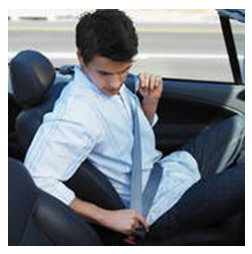 The purpose of seatbelts and shoulder straps is to keep your body from hitting the steering wheel, windshield or other portions of the interior of your car in a crash. Safety belts are also effective in preventing total ejection from a car in a crash. If you are struck from the side in a collision, the impact could push you back and forth across the seat. Seatbelts help to keep you in a better position to control the vehicle.
The purpose of seatbelts and shoulder straps is to keep your body from hitting the steering wheel, windshield or other portions of the interior of your car in a crash. Safety belts are also effective in preventing total ejection from a car in a crash. If you are struck from the side in a collision, the impact could push you back and forth across the seat. Seatbelts help to keep you in a better position to control the vehicle.
Safety belts can reduce injuries and deaths.
- Unrestrained occupants of a car keep moving during the time the car takes to stop due to inertia. They will still be moving forward at their original speed when they slam into the steering wheel, windshield or other part of the car. This force is equivalent to that of hitting the ground when falling from a three-story building. When hit from behind, inertia causes a person’s neck to bend backwards, which can result in whiplash.
To be effective, seatbelts must be worn properly.
- The shoulder belt should fit snuggly against your body
- You should never wear the shoulder belt under your arm
- You should never wear a seatbelt that is twisted
- You should never be reclined in your seat when moving.
Seat belts, both the lap belt and shoulder harness, must be in good working order. You may not operate your vehicle on public roads or on private property, such as parking lots, unless you and all of your passengers eight years of age or older or who are 4 feet 9 inches tall or taller, are wearing seatbelts.
Children younger than eight years old or who are less than 4 feet 9 inches tall are seated in a federally approved child passenger restraint system.
You and your passengers must wear seat belts while your vehicle is moving on public roads and on private property, such as parking lots.
If seat belts are not worn by any of your passengers, you and the passenger(s) can be cited. If the passenger is younger than 16 years of age, you will be cited if he or she is not wearing his or her seat belt.
Always use your seat belts (including the shoulder harness) even if the vehicle is equipped with air bags. You can have shoulder harnesses or seat belts installed in older vehicles. Even if you wear only a lap belt when driving, your chances of living through a collision are twice as high as someone who does not wear a lap belt. If you wear a lap and shoulder belt, your chances are three to four times higher to live through a collision.
Pregnant women should wear the lap belt as low as possible under the abdomen, and the shoulder strap should be placed between the breasts and to the side of the abdomen’s bulge.
Note:
Using seatbelts reduces the risk of being thrown from your vehicle in a collision. If you do not install and use a shoulder harness with the seat (lap) belt, serious or fatal injuries may happen in some crashes. Lap-only belts increase the chance of spinal column and abdominal injuries—especially in children. Shoulder harnesses may be available for your vehicle, if it is not already equipped with them.
 Click for more information about “Choosing the Right Seat for the Child”
Click for more information about “Choosing the Right Seat for the Child”http://www.mto.gov.on.ca/english/safety/carseat/choose.shtml
Airbags
Air bags, combined with lap/shoulder safety belts offer the most effective safety protection available today for passenger vehicles. Air bags are designed to provide protection over and above what the seat belt provides. They are gas-inflated cushions built into the steering wheel, dashboard, door, roof or seat of your car that use a crash sensor to trigger a rapid expansion to protect you from the impact of an accident.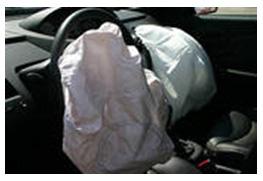
- For the maximum air bag protection
- Sit back at least 10 inches from the steering wheel and dashboard.
- Always wear your seat belt properly.
- If your steering wheel tilts, direct it toward your chest, not your head.
- If you are pregnant, place the lap belt low on your abdomen with the shoulder portion over the collarbone.
- Always seat children in the back seat when possible, even if there is no airbag in front of them.
- Avoid putting children in the front seat of a car equipped with airbags.
- Children sitting in the front seat with an air bag could be severely injured by the airbag. Even when kids get older, riding in the back seat is safer.
Headlights
Headlights should be used:
- When it is cloudy, raining, snowing or foggy
- On frosty mornings when windshields may be icy or foggy
- On country or mountain roads to make it easier for other drivers to see you
- Anytime you do not have enough light to see for at least 1000 feet
- Anytime it would help you see and be seen better
- No later than 30 minutes after sunset and until at least 30 minutes before sunrise.
You should use your high-beam headlights whenever you are having trouble seeing with your normal headlights, except when it is raining, foggy, snowing, or when it may blind other drivers.
You must:
- Dim your high beams for oncoming vehicles by the time they are within 500 feet of your vehicle
- Dim your high beams when the vehicle you are following is within 300 feet.
- You may flash your headlights to get the attention of another driver so as to avoid an accident.
Signaling Indicators
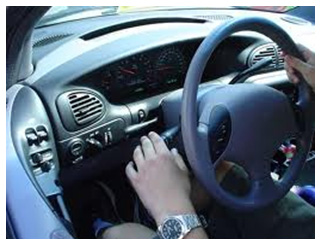 The signals are the lighting devices that allow you to inform other drivers on the roadway what your intentions are.
The signals are the lighting devices that allow you to inform other drivers on the roadway what your intentions are.
Considerations to take:
- Do not assume that just because you have signaled a turn or lane change that others can or will leave you the space to complete it.
- You must signal even when you don’t see any cars around.
- You should use both arm signals and signal lights if it is difficult for others to see your signal lights.
- You must signal before turning, changing lanes, or otherwise entering traffic from a side road or driveway.
- You should signal during the last 100 feet before turning unless traffic conditions indicate you should start signaling earlier, such as on a freeway where you should signal for at least 5 seconds before changing lanes.
- In addition to signaling the intention to make a turn, you must check your mirrors and blind spots to make sure it is safe to complete the maneuver.
- If you plan to turn as soon as you leave an intersection, do not start signaling while you are approaching or in the intersection. Wait until you have crossed the intersection so as not to confuse traffic.
- Make sure that your signal is turned off after you have completed your turn or lane change.
Hand Gestures
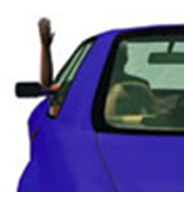 To indicate a right turn the driver should lower the driver’s window and put their left arm out in an “L” shape. The arm should be straight out from the shoulder and bent up towards the sky from the elbow to the hand. This will inform the other drivers of the right turn.
To indicate a right turn the driver should lower the driver’s window and put their left arm out in an “L” shape. The arm should be straight out from the shoulder and bent up towards the sky from the elbow to the hand. This will inform the other drivers of the right turn.
 To indicate a left turn, the driver should completely extend the arm straight out. This will inform the other drivers on the road of your intentions.
To indicate a left turn, the driver should completely extend the arm straight out. This will inform the other drivers on the road of your intentions.
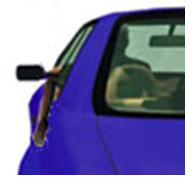 To indicate a stop or slowing down, the driver should extend the arm out straight from the shoulder, and at the elbow the arm should bend straight down towards the ground. This will allow other drivers to be prepared for your vehicle to slow or stop.
To indicate a stop or slowing down, the driver should extend the arm out straight from the shoulder, and at the elbow the arm should bend straight down towards the ground. This will allow other drivers to be prepared for your vehicle to slow or stop.
Other Safety Considerations
- Backup lights:
- Help avoid collisions while you are backing up at night by improving visibility
- Alert others to the fact that you are backing up or about to back up.
- Never drive a vehicle loaded with things, such as boxes, in such a manner that you cannot see ahead or to the sides and impairs your ability to stop or safely maneuver at highway speeds.
- You may not carry objects on a passenger vehicle that:
- Extend beyond the fender line on the left side
- Extend more than 6 inches beyond the fender line on the right side
- Extend more than four feet from the rear of the vehicle, unless during the day you have attached a 12-inch red or fluorescent orange flag or during the night have attached two red lights.
- If you are towing a trailer or another vehicle, it must also have its own tail, brake, and turn lights that function simultaneously with those of your vehicle.
- The Vehicle Code specifies braking distances that are required for vehicles.
- These standards differ for different sizes and weights of vehicles, and these distances will be greater for larger, heavier vehicles. You should apply your brakes smoothly to avoid a locked- wheel skid.
- Anticipate when you will need to stop so you can do so gradually. Smooth, gradual braking minimizes the likelihood of being rear-ended, save gas and avoid unnecessary wear on your brakes.
- Mirrors should provide a view for at least 200 feet to the rear of your vehicle. Two mirrors are required on all vehicles. A right side mirror is required and either a rear view or left side mirror. You should properly adjust your mirrors before starting to drive, to avoid being distracted while attempting to adjust them during driving.
- Maintaining good visibility requires that you keep windshields and mirrors clean and free from obstructions.
- If your windshield is cracked and obstructs your view or that of your passenger, you will not be allowed to take your driving test.
- You must not carry objects, inside or outside that obscure your view.
- Windshield wipers lose their ability to effectively clean your windshield by cracking, loosing their flexibility, becoming dirty and getting out of adjustment. Therefore, it is a safe practice is to change them annually.
- Temperature and humidity conditions may change rapidly causing frost and condensation to quickly form on the windshield. For this reason, it is important to keep the defroster in good operating condition.
- Vehicles are required to have a functioning horn or similar audible warning device.
- It must be audible under normal driving conditions for at least 200 feet from your vehicle.
- It is appropriate to sound your horn to avoid accidents by alerting other drivers to your presence. Also, it is appropriate to sound your horn on narrow mountain roads when you cannot see 200 feet ahead while driving as far right as possible.
- It is NOT appropriate to sound your horn:
- Because someone is driving slowly
- To chastise other drivers who have made a mistake
- Because you are angry
- When by slowing or stopping you can avoid the dangerous situation
- For any other reason, except to help avoid an accident.
- The minimum legal tread depth for tires is 1/32 of an inch for most passenger vehicles, (b) 4/32 of an inch for busses, most trucks, and most trailers, and is 6/32 of an inch for snow tires. To avoid skidding, blowouts and unsafe handling, the manufacturer’s recommendations for your vehicle should be followed in selecting tires.
- It is recommended to keep the following in your vehicle:
- Flares
- First-aid kit
- Fire extinguisher
- Basic tools
- Flashlight
- Tire chains
- When driving in desolate areas, it is important to be prepared to deal with being stranded due to a break down by having water, food and warm clothing available.

